Single Mode, Air-Cladded Optical Waveguides Supported by a Nano-Fin Fabricated with Direct Laser Writing
Abstract
:1. Introduction
2. Optical Waveguide Cross-Section Design and Simulation
2.1. Bending Loss
2.2. Waveguide Taper for Mode Matching
2.3. Waveguide Design for an Evanescent Field Sensor/Probe
3. Waveguide Fabrication and Its Nano-Characterization
4. Waveguide Characterization
Propagation Loss Estimation
5. Conclusions
Author Contributions
Funding
Acknowledgments
Conflicts of Interest
Appendix A
References
- Joe, H.-E.; Yun, H.; Jo, S.H.; Jun, M.B.; Min, B.K. A Review on Optical Fiber Sensors for Environmental Monitoring. Int. J. Precis. Eng. Manuf. Green Technol. 2018, 5, 173–191. [Google Scholar] [CrossRef]
- Horváth, R.; Pedersen, H.C.; Skivesen, N.; Selmeczi, D.; Larsen, N.B. Optical waveguide sensor for on-line monitoring of bacteria. Opt. Lett. 2003, 28, 1233–1235. [Google Scholar] [CrossRef] [Green Version]
- Kaur, P.; Shenoy, M. Highly Sensitive Refractive Index Sensor based on Silicon Nitride Strip Waveguide Directional Coupler. IEEE Sens. Lett. 2018, 2, 3500504. [Google Scholar] [CrossRef]
- Qian, Y.; Zhao, Y.; Wu, Q.L.; Yang, Y. Review of salinity measurement technology based on optical fiber sensor. Sens. Actuators B Chem. 2018, 260, 86–105. [Google Scholar] [CrossRef]
- Willer, U. Fiber-optic evanescent-field laser sensor for in-situ gas diagnostics. Spectrochim. Acta Part A Mol. Biomol. Spectrosc. 2002, 58, 2427–2432. [Google Scholar] [CrossRef]
- Schmitt, K.; Schirmer, B.; Hoffmann, C.; Brandenburg, A.; Meyrueis, P. Interferometric biosensor based on planar optical waveguide sensor chips for label-free detection of surface bound bioreactions. Biosens. Bioelectron. 2007, 22, 2591–2597. [Google Scholar] [CrossRef]
- Knoerzer, M.; Szydzik, C.; Ren, G.; Huertas, C.S.; Palmer, S.; Tang, P.; Nguyen, T.G.; Bui, L.; Boes, A.; Mitchell, A. Optical frequency comb based system for photonic refractive index sensor interrogation. Opt. Express 2019, 27, 21532. [Google Scholar] [CrossRef]
- Soler, M.; Huertas, C.S.; Lechuga, L.M. Label-free plasmonic biosensors for point-of-care diagnostics: A review. Expert Rev. Mol. Diagn. 2019, 19, 71–81. [Google Scholar] [CrossRef]
- Xu, F.; Brambilla, G. Demonstration of a refractometric sensor based on optical microfiber coil resonator. Appl. Phys. Lett. 2008, 92, 101126. [Google Scholar] [CrossRef] [Green Version]
- Sumetsky, M.; Dulashko, Y.; Fini, J.M.; Hale, A.; DiGiovanni, D.J. The Microfiber Loop Resonator: Theory, Experiment, and Application. J. Lightwave Technol. 2006, 24, 242–250. [Google Scholar] [CrossRef]
- Vlk, M.; Datta, A.; Alberti, S.; Yallew, H.D.; Mittal, V.; Murugan, G.S.; Jágerská, J. Extraordinary evanescent field confinement waveguide sensor for mid-infrared trace gas spectroscopy. Light Sci Appl. 2021, 10, 26. [Google Scholar] [CrossRef] [PubMed]
- Vollmer, F.; Yang, L. Label-free detection with high-Q microcavities: A review of biosensing mechanisms for integrated devices. Nanophotonics 2012, 1, 267–291. [Google Scholar] [CrossRef] [PubMed] [Green Version]
- Zou, Y.; Chakravarty, S.; Chung, C.J.; Xu, X.; Chen, R.T. Mid-infrared silicon photonic waveguides and devices. Photonics Res. 2018, 6, 254–276. [Google Scholar] [CrossRef]
- Swargiary, K.; Jarutatsanangkoon, P.; Suwanich, P.; Jolivot, R.; Mohammed, W.S. Single-step 3D-printed integrated optical system and its implementation for a sensing application using digital light processing technology. Appl. Opt. 2020, 59, 122–128. [Google Scholar] [CrossRef]
- Gross, A.J.; Bertoldi, K. Additive Manufacturing of Nanostructures That Are Delicate, Complex, and Smaller than Ever. Small 2019, 15, 1–6. [Google Scholar] [CrossRef] [PubMed]
- Serbin, J.; Ovsianikov, A.; Chichkov, B. Fabrication of woodpile structures by two-photon polymerization and investigation of their optical properties. Opt. Express 2004, 12, 5221–5228. [Google Scholar] [CrossRef] [Green Version]
- Frenzel, T.; Kadic, M.; Wegner, M. Three dimensional mechanical metamaterials with a twist. Science 2017, 358, 1072–1074. [Google Scholar] [CrossRef] [Green Version]
- Bückmann, T.; Stenger, N.; Kadic, M.; Kaschke, J.; Frölich, A.; Kennerknecht, T.; Wegener, M. Tailored 3D Mechanical Metamaterials Made by Dip-in Direct-Laser-Writing Optical Lithography. Adv. Mater. 2012, 24, 2710–2714. [Google Scholar] [CrossRef]
- Gale, B.K.; Jafek, A.R.; Lambert, C.J.; Goenner, B.L.; Moghimifam, H.; Nze, U.C.; Kamarapu, S.K. A Review of Current Methods in Microfluidic Device Fabrication and Future Commercialization Prospects. Inventions 2018, 3, 60. [Google Scholar] [CrossRef] [Green Version]
- Schmid, M.; Thiele, S.; Herkommer, A.; Giessen, H. Three-dimensional direct laser written achromatic axicons and multi-component microlenses. Opt. Lett. 2018, 43, 5837. [Google Scholar] [CrossRef]
- West, H.; Garcia, Y.; Rechtman, L.; Blau, M.; Marom, D.M. Subwavelength Nano-Pyramids 3D Printed Directly on Optical Fiber Tip Serving as Anti-Reflection Coating. In Proceedings of the 2018 International Conference on Optical MEMS and Nanophotonics (OMN), Lausanne, Switzerland, 29 July–2 August 2018; pp. 1–5. [Google Scholar]
- Lindenmann, N.; Balthasar, G.; Hillerkuss, D.; Schmogrow, R.; Jordan, M.; Leuthold, J.; Koos, C. Photonic wire bonding: A novel concept for chip-scale interconnects. Opt. Express 2012, 20, 17667. [Google Scholar] [CrossRef] [Green Version]
- Vanmol, K.; Saurav, K.; Panapakkam, V.; Thienpont, H.; Vermeulen, N.; Watté, J.; Van Erps, J. Mode-field matching down-Tapers on single-mode optical fibers for edge coupling towards generic photonic integrated circuit platforms. J. Lightwave Technol. 2020, 38, 4834–4842. [Google Scholar] [CrossRef]
- Gao, H.; Chen, G.F.; Xing, P.; Choi, J.W.; Low, H.Y.; Tan, D.T. High-Resolution 3D Printed Photonic Waveguide Devices. Adv. Opt. Mater. 2020, 8, 2000613. [Google Scholar] [CrossRef]
- Schmid, M.; Ludescher, D.; Giessen, H. Optical properties of photoresists for femtosecond 3D printing: Refractive index, extinction, luminescence-dose dependence, aging, heat treatment and comparison between 1-photon and 2-photon exposure. Opt. Mater. Express 2019, 9, 4564. [Google Scholar] [CrossRef]
- Brimont, A.; Hu, X.; Cueff, S.; Romeo, P.R.; Saint Girons, G.; Griol, A.; Orobtchouk, R. Low-Loss and compact silicon rib waveguide bends. IEEE Photonics Technol. Lett. 2016, 28, 299–302. [Google Scholar] [CrossRef] [Green Version]
- 3M Company. 3M™ Novec™ 7100 Engineered Fluid; 3M Company: St. Paul, MN, USA, 2020; Available online: http://multimedia.2m.com.mediawebserver (accessed on 3 July 2021).
- Shi, Y.; Ma, L.; Zhuang, Y.; He, Z. Investigation on roughness-induced scattering loss of small-core polymer waveguides for single-mode optical interconnect applications. Opt. Express 2020, 28, 38733. [Google Scholar] [CrossRef] [PubMed]
- Regener, R.; Sohler, W. Loss in low-finesse Ti:LiNbO3 optical waveguide resonators. Appl. Phys. B 1985, 36, 143–147. [Google Scholar] [CrossRef]
- Taebi, S.; Khorasaninejad, M.; Saini, S.S. Modified Fabry-Perot interferometric method for waveguide loss measurement. Appl. Opt. 2008, 47, 6625–6630. [Google Scholar] [CrossRef]

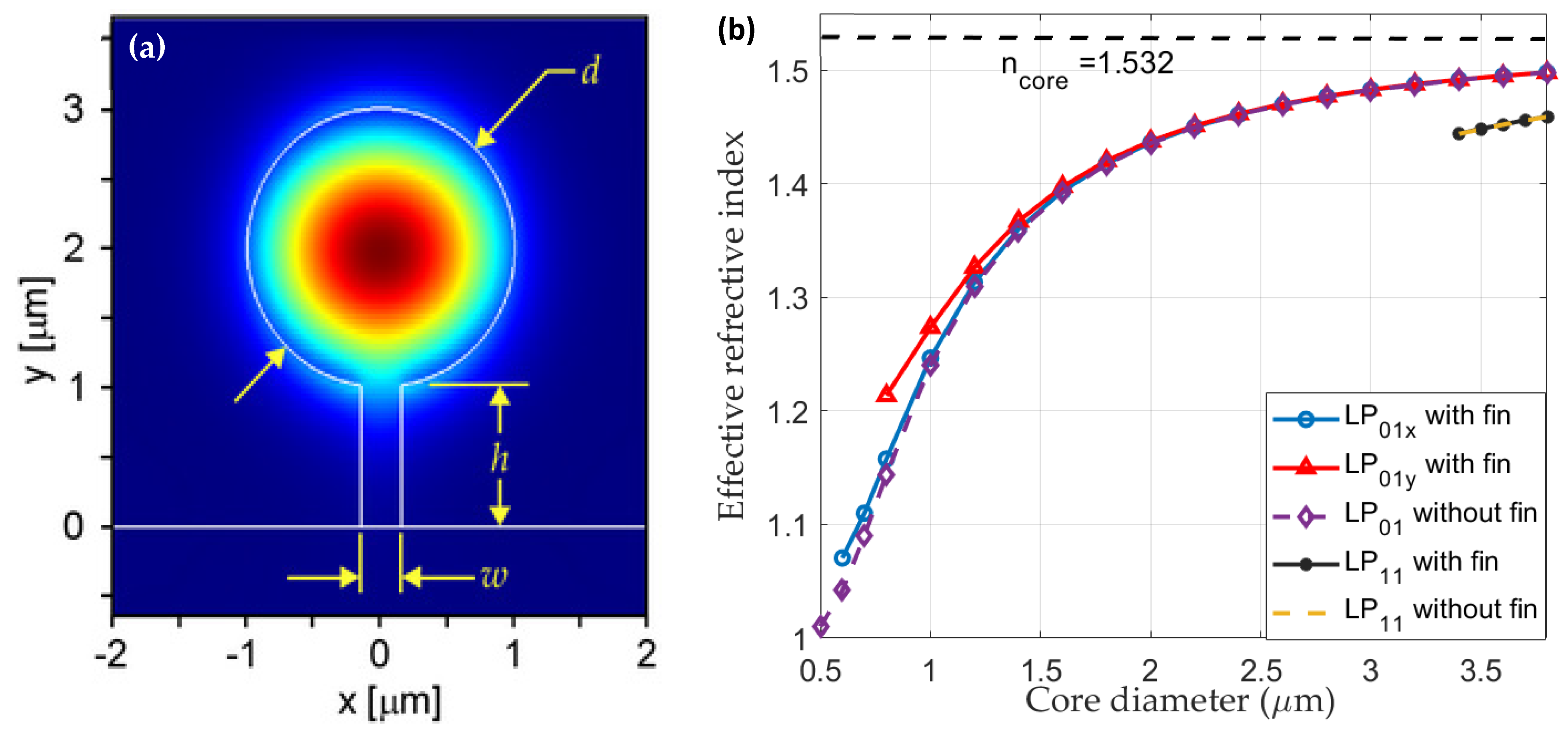
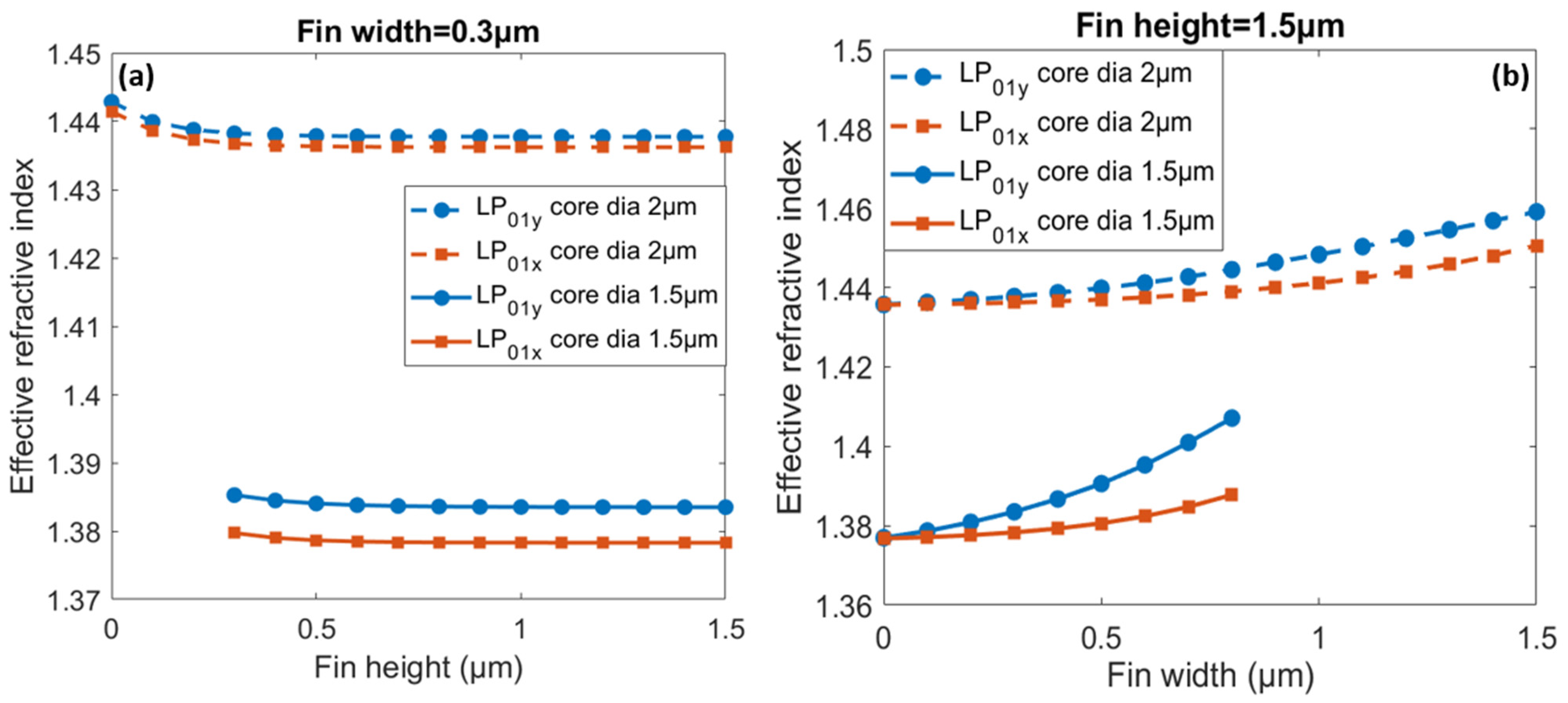

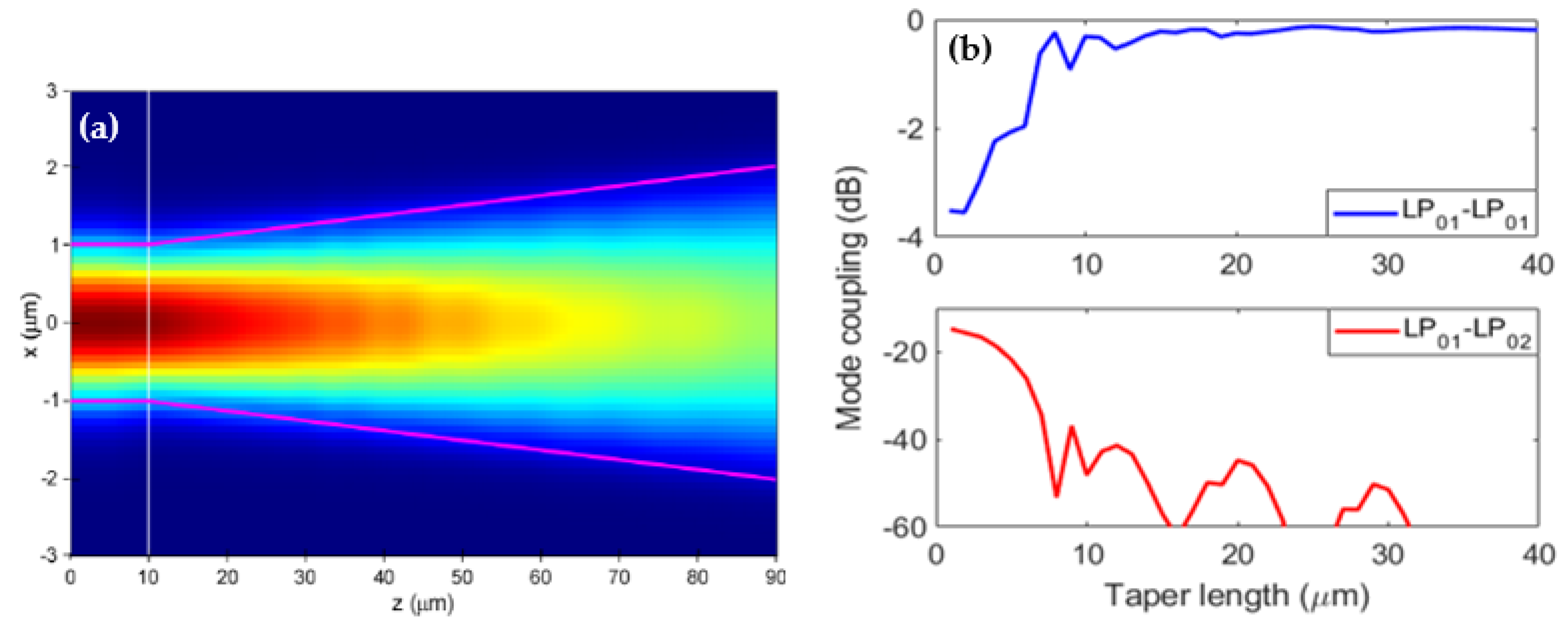
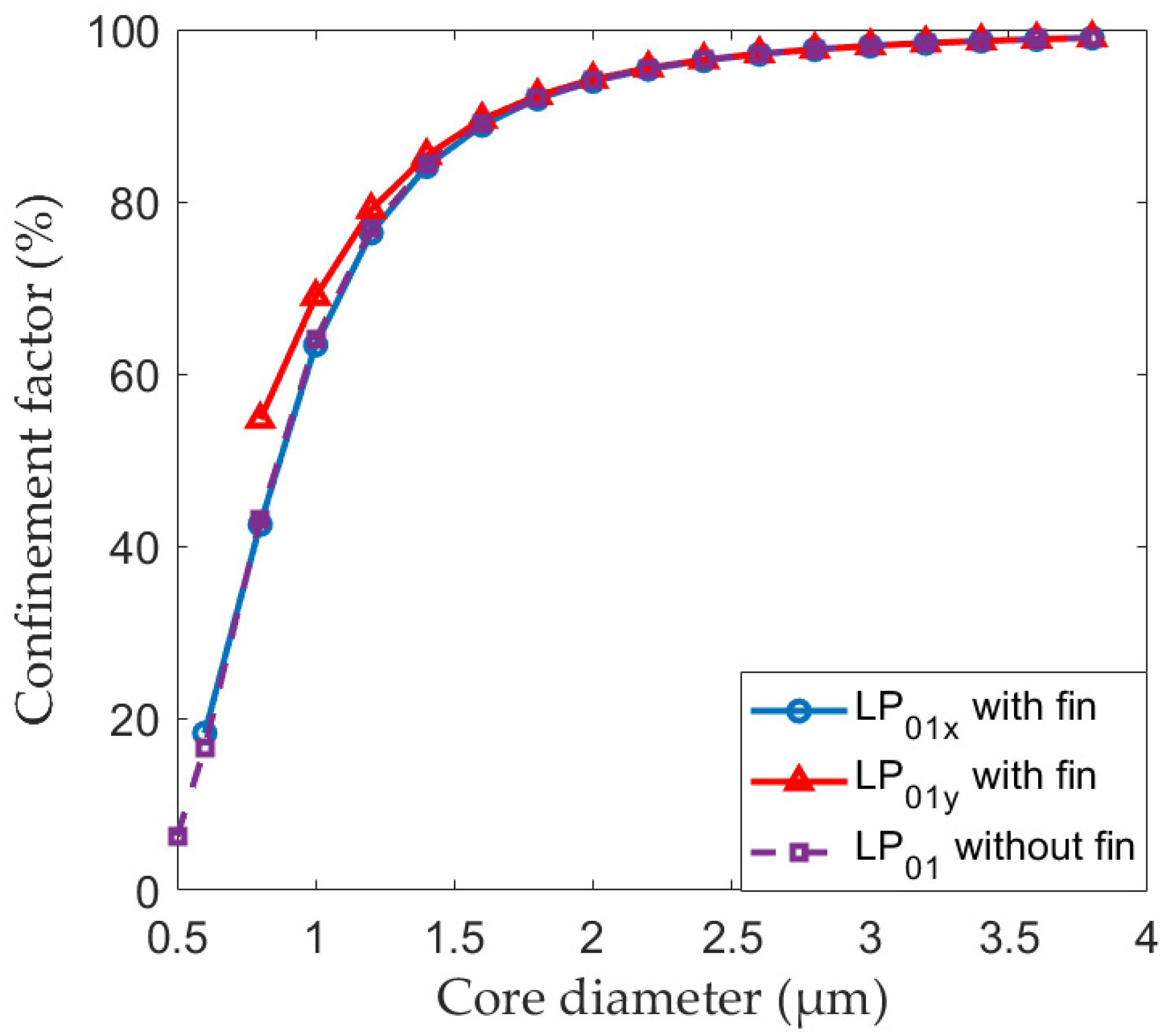

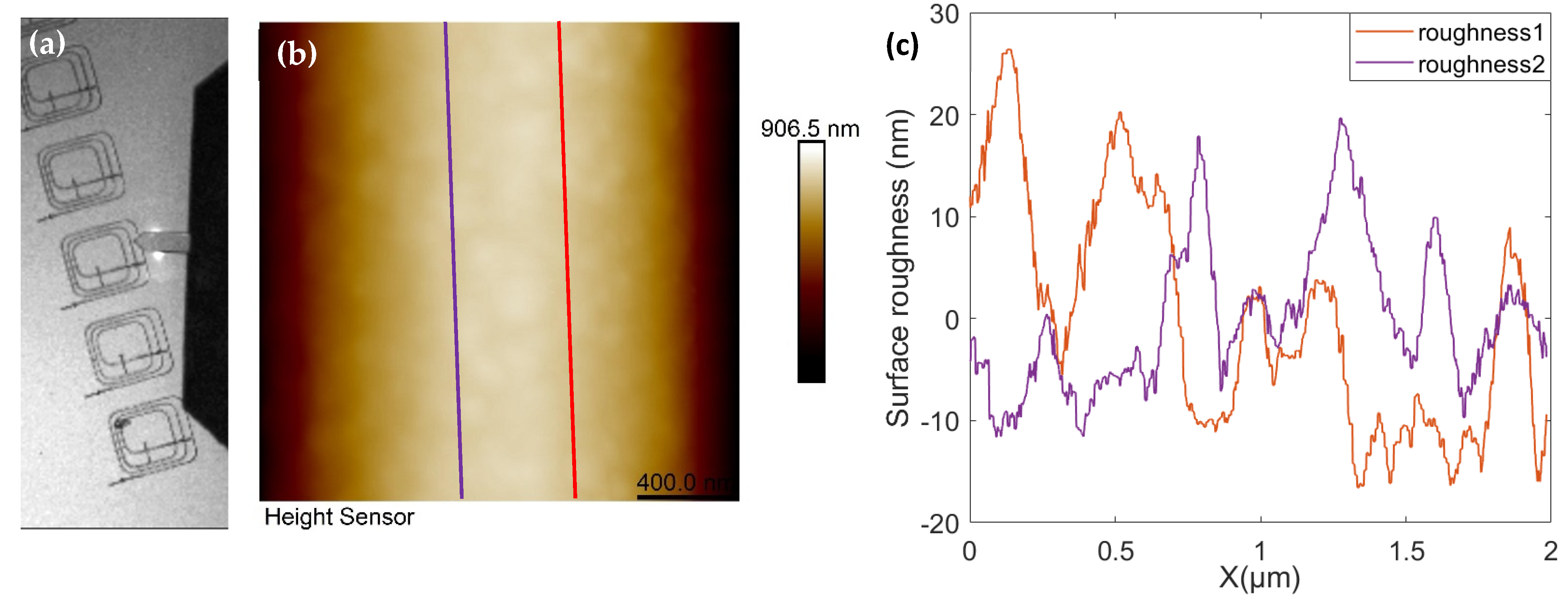


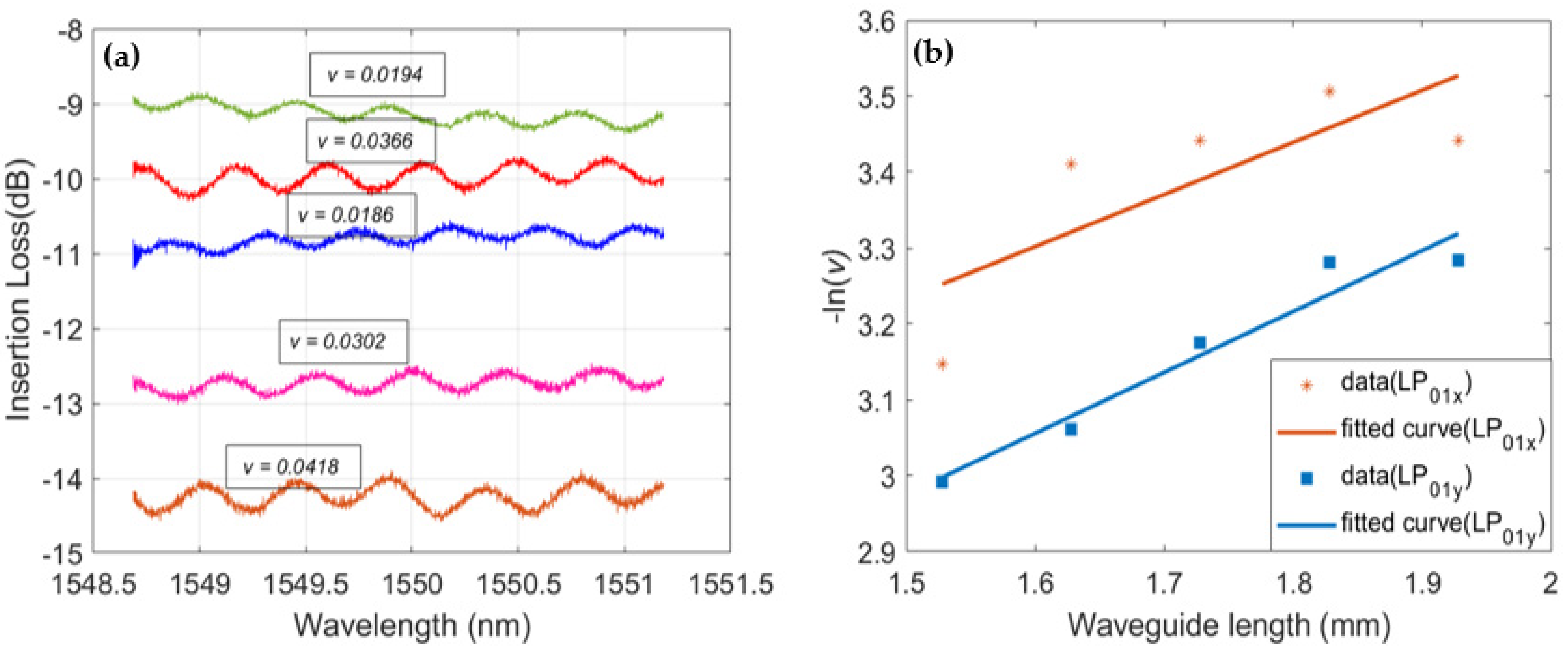
Publisher’s Note: MDPI stays neutral with regard to jurisdictional claims in published maps and institutional affiliations. |
© 2021 by the authors. Licensee MDPI, Basel, Switzerland. This article is an open access article distributed under the terms and conditions of the Creative Commons Attribution (CC BY) license (https://creativecommons.org/licenses/by/4.0/).
Share and Cite
Gill, P.K.; Marom, D.M. Single Mode, Air-Cladded Optical Waveguides Supported by a Nano-Fin Fabricated with Direct Laser Writing. Appl. Sci. 2021, 11, 6327. https://doi.org/10.3390/app11146327
Gill PK, Marom DM. Single Mode, Air-Cladded Optical Waveguides Supported by a Nano-Fin Fabricated with Direct Laser Writing. Applied Sciences. 2021; 11(14):6327. https://doi.org/10.3390/app11146327
Chicago/Turabian StyleGill, Parvinder K., and Dan M. Marom. 2021. "Single Mode, Air-Cladded Optical Waveguides Supported by a Nano-Fin Fabricated with Direct Laser Writing" Applied Sciences 11, no. 14: 6327. https://doi.org/10.3390/app11146327




